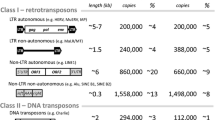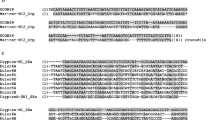Summary
In a recent report mouse B1 genomic repeats were divided into six families representing different waves of fixation of B1 variants, consistent with the retroposition model of human Alu elements. These data are used to examine the distribution of nucleotide substitutions in individual genomic repeats with respect to family consensus sequences and to compare the minimal energy structures of the corresponding B1 RNAs. By an enzymatic approach the predicted structure of B1 RNAs is experimentally confirmed using as a model sequence an RNA of a young B1 family member transcribed in vitro by T7 RNA polymerase. B1 RNA preserves folding domains of the Alu fragment of 7SL RNA, its progenitor molecule. Our results reveal similarities among 7SL-like retroposons, human Alu, and rodent B1 repeats, and relate the evolutionary conservation of B1 family consensus sequences to selection at the RNA level.
Similar content being viewed by others
References
Andrews PG, Kole R (1987) Alu RNA transcribed in vitro binds the 68-kDa subunit of the signal recognition particle. J Biol Chem 262:2908–2912
Bird PA (1987) CpG islands as gene markers in the vertebrate nucleus. Trends Genet 3:342–347
Britten RJ, Baron WF, Stout DB, Davidson EH (1988) Sources and evolution of human Alu repeated sequences. Proc Natl Acad Sci USA 85:4770–4774
Britten RJ, Stout DB, Davidson EH (1989) The current source of human Alu retroposons is a conserved gene shared with Old World monkey. Proc Natl Acad Sci USA 85:3718–3722
D'Alessio JM (1982) RNA sequencing. In: Rickwood D, Hames BD (eds) Gel electrophoresis of nucleic acids. IRL Press, Washington DC, pp 177–198
Daniels GR, Deininger PL (1983) A second major class of Alu family repeated DNA sequences in a primate genome. Nucleic Acids Res 11:7595–7610
Deininger PL, Slagel VK (1968) Recently amplified Alu family members share common parental alu sequence. Mol Cell Biol 8:4566–4569
Deragon J-M, Sinnett D, Labuda D (1990) Reverse transcriptase activity from human embryonal carcinoma cells NTera2D1. EMBO J 9:3363–3368
Economou-Pachnis A, Tsichlis PN (1985) Insertion of an Alu Sine in the human homologue of the Mlvi-2 locus. Nucleic Acids Res 13:8379–8387
Felsenstein J (1988) Phylogenies from molecular sequences: inference and reliability. Annu Rev Genet 22:521–565
Gundelfinger ED, DiCarlo M, Zopf D, Melli M (1984) Structure and evolution of the 7SL RNA component of signal recognition particle. EMBO J 3:2325–2332
Jurka J (1989) Subfamily structure and evolution of the human L1 family of repetitive sequences. J Mol Evol 29:496–503
Jurka J, Smith T (1988) A fundamental division in the Alu family of repeated sequences. Proc Natl Acad Sci USA 85: 4775–4778
Labuda D, Striker G (1989) Sequence conservation in Alu evolution. Nucleic Acids Res 17:2477–2491
Li W-H, Gojobori T, Nei M (1981) Rseudogenes as a paradigm of neutral evolution. Nature 292:237–239
Li W-H, Tanimura M (1987) The molecular clock runs more slowly in man than in apes and monkeys. Nature 326:93–96
Matera GA, Hellmann U, Schmid CW (1990) A transpositionally and transcriptionally competent Alu subfamily. Mol Cell Biol 10:5424–5432
Milligan JF, Groebe R, Witherell GW, Uhlenbeck OC (1987) Oligoribonucleotide synthesis using T7 RNA polymerase and synthetic DNA templates. Nucleic Acids Res 15:8783–8798
Perez-Stable C, Shen C-KJ (1986) Competitive and cooperative functioning of the anterior and posterior promoter elements of an Alu family repeat. Mol Cell Biol 6:2041–2052
Poritz MA, Strub K, Walter P (1988) Human SRP RNA andE. coli 4.5S RNA contain a highly homologous structural domain. Cell 55:4–6
Quentin Y (1988) The Alu family developed through successive waves of fixation closely connected with primate lineage history. J Mol Evol 27:194–202
Quentin Y (1989) Successive waves of fixation of B1 variants in rodent lineage history. J Mol Evol 28:299–305
Reddy R (1988) Compilation of small RNA sequences. Nucleic Acids Res 16:r71-r86
Rogers JH (1985) The origin and evolution of retroposons. Int Rev Cytol 93:187–279
Ryan SC, Dugaiczyk A (1989) Newly arisen DNA repeats in primate phylogeny. Proc Natl Acad Sci USA 86:9360–9364
Schmid CW, Shen C-KJ (1985) The evolution of interspersed repetitive DNA sequences in mammals and other vertebrates. In: MacIntyre RJ (ed) Molecular evolutionary genetics. Plenum, New York, pp 323–358
Shumyatsky GP, Tillib SV, Kramerov DA (1990) B2 RNA and 7SK RNA, RNA polymerase III transcripts, have a cap-like structure at their 5′ end. Nucleic Acids Res 18:6347–6351
Siegel V, Walter P (1988) Each of the activities of signal recognition particle (SRP) is contained within a distinct domain: analysis of biochemical mutants of SRP. Cell 52:39–49
Sinnett D, Deragon J-M, Simard LR, Labuda D (1990) Alumorphs-human DNA polymorphisms detected by polymerase chain reaction using Alu-specific primers. Genomics 7:331–334
Sinnett D, Richer Ch, Deragon J-M, Labuda D (1991) Alu RNA secondary structure consists of two independent 7SL RNA-like folding units. J Biol Chem (in press)
Stoppa-Lyonnet D, Carter PE, Meo T, Tosi M (1990) Clusters of intragenic Alu repeats predispose the human C1 inhibitor locus to deleterious rearrangements. Proc Natl Acad Sci USA 87:1551–1555
Trabuchet G, Chebloune Y, Savatier P, Lachuer J, Faure C, Verdier G, Nigon VM (1987) Recent insertion of an Alu sequence in the beta-globin gene cluster of the gorilla. J Mol Evol 25:288–291
Turner DH, Sugimoto N, Jaeger JA, Longfellow CE, Freier SM, Kierzek R (1987) Improved parameters for prediction of RNA structure. Cold Spring Harbor Symp Quant Biol 52: 123–133
Ullu E, Tschudi C (1984) Alu sequences are processed 7SL RNA genes. Nature 312:171–172
Ullu E, Weiner AM (1984) Human genes and pseudogenes for the 7SL RNA component of signal recognition particle. EMBO J 3:3303–3310
Weiner AM, Deininger PL, Efstratiadis A (1986) Nonviral retroposons: genes, pseudogenes, and transposable elements generated by reverse flow of genetic information. Annu Rev Biochem 55:631–661
Willard C, Nguyen HT, Schmid CW (1987) Existence of at least three distinct Alu subfamilies. J Mol Evol 26:180–186
Xiong Y, Eickbush TH (1990) Origin and evolution of retroelements based upon their reverse transcriptase sequences. EMBO J 9:3353–3362
Young R, Scott RW, Hamer DH, Tilghman SM (1982) Construction and expression in vivo of an internally deleted mouse alpha-fetoprotein gene: presence of a transcribed Alu-like repeat within the first intervening sequence. Nucleic Acids Res 10:3099–3116
Zuker M (1989) Computer prediction of RNA structure. Methods in Enzymology 180:262–288
Zwieb C (1985) The secondary structure of the 7SL RNA in the signal recognition particle: functional implications. Nucleic Acids Res 13:6105–6124
Author information
Authors and Affiliations
Rights and permissions
About this article
Cite this article
Labuda, D., Sinnett, D., Richer, C. et al. Evolution of mouse B1 repeats: 7SL RNA folding pattern conserved. J Mol Evol 32, 405–414 (1991). https://doi.org/10.1007/BF02101280
Received:
Revised:
Accepted:
Issue Date:
DOI: https://doi.org/10.1007/BF02101280




